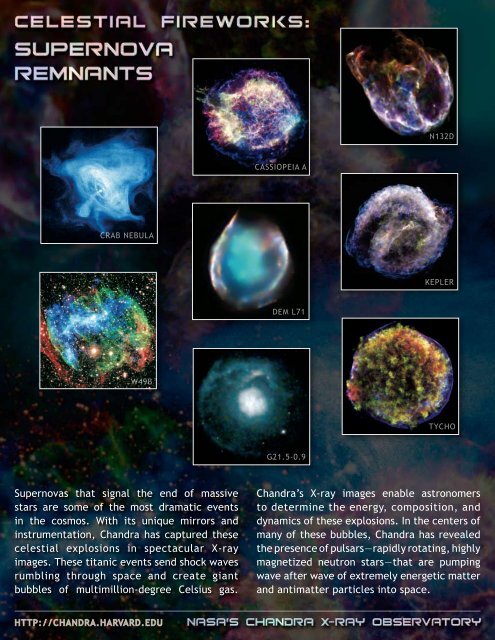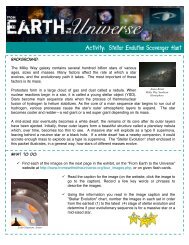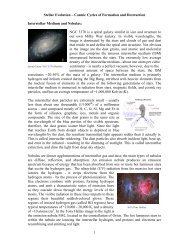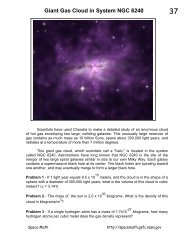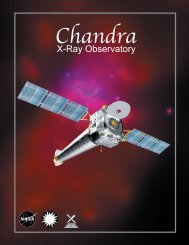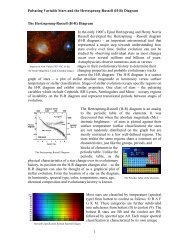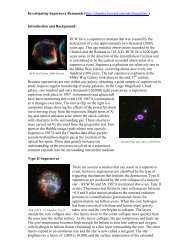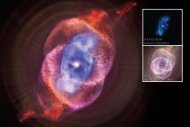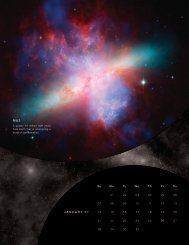Supernova Remnants - Chandra X-ray Observatory
Supernova Remnants - Chandra X-ray Observatory
Supernova Remnants - Chandra X-ray Observatory
You also want an ePaper? Increase the reach of your titles
YUMPU automatically turns print PDFs into web optimized ePapers that Google loves.
crab nebula<br />
W49b<br />
<strong>Supernova</strong>s that signal the end of massive<br />
stars are some of the most dramatic events<br />
in the cosmos. With its unique mirrors and<br />
instrumentation, <strong>Chandra</strong> has captured these<br />
celestial explosions in spectacular X-<strong>ray</strong><br />
images. These titanic events send shock waves<br />
rumbling through space and create giant<br />
bubbles of multimillion-degree Celsius gas.<br />
hTTp://<strong>Chandra</strong>.harvard.edu<br />
Cassiopeia a<br />
DEM L71<br />
G21.5-0.9<br />
N132D<br />
Kepler<br />
Tycho<br />
<strong>Chandra</strong>’s X-<strong>ray</strong> images enable astronomers<br />
to determine the energy, composition, and<br />
dynamics of these explosions. In the centers of<br />
many of these bubbles, <strong>Chandra</strong> has revealed<br />
the presence of pulsars—rapidly rotating, highly<br />
magnetized neutron stars—that are pumping<br />
wave after wave of extremely energetic matter<br />
and antimatter particles into space.
A Look at <strong>Supernova</strong> <strong>Remnants</strong> with the <strong>Chandra</strong> X-<strong>ray</strong> <strong>Observatory</strong><br />
every 50 years or so, a massive star in our Galaxy<br />
blows itself apart in a supernova explosion. Superno -<br />
vas are one of the most violent events in the universe,<br />
and the force of the explosion generates a blinding<br />
flash of radiation, as well as shock waves analogous<br />
to sonic booms.<br />
There are two types of supernovas: Type II, where a<br />
massive star explodes; and Type Ia, where a white<br />
dwarf collapses because it has pulled too much mate -<br />
rial from a nearby companion star onto itself.<br />
The general picture for a Type II supernova goes some -<br />
thing like this. When the nuclear power source at the<br />
center or core of a star is exhausted, the core col -<br />
lapses. In less than a second, a neutron star (or black<br />
hole, if the star is extremely massive) is formed. as infalling<br />
matter crashes down on the neutron star, tem -<br />
peratures rise to billions of degrees Celsius. Within<br />
hours, a catastrophic explosion occurs, and all but the<br />
central neutron star is blown away at speeds in excess<br />
of 50 million kilometers per hour. a thermonuclear<br />
shock wave races through the now expanding stellar<br />
debris, fusing lighter elements into heavier ones and<br />
producing a brilliant visual outburst that can be as<br />
intense as the light of several billion Suns!<br />
The matter thrown off by the explosion plows through<br />
the surrounding gas producing shock waves that create<br />
a shell of multimillion - degree gas and high -energy<br />
particles called a supernova remnant. The supernova<br />
remnant will produce intense radio and X - radiation for<br />
thousands of years.<br />
In several young supernova remnants the rapidly rotat -<br />
ing neutron star at the center of the explosion gives off<br />
pulsed radiation at X-<strong>ray</strong> and other wavelengths, and<br />
creates a magnetized bubble of high-energy particles<br />
whose radiation can dominate the appearance of the<br />
remnant for a thousand years or more.<br />
eventually, after rumbling across several thousand light<br />
years, the supernova remnant will disperse. <strong>Supernova</strong>s<br />
heat the interstellar gas, seed it with heavy elements,<br />
Crab Nebula: The Crab nebula was first observed by Chinese astronomers in 1054 a.d., and this<br />
stellar debris left behind from a supernova explosion has since become one of the most studied<br />
objects in the sky. This image from <strong>Chandra</strong> provides a dramatic look at the activity generated<br />
by the pulsar (white dot near the center of the image) in the Crab nebula. The inner X-<strong>ray</strong> ring is<br />
thought to be a shock wave that marks the boundary between the surrounding nebula and the flow<br />
of matter and antimatter particles from the pulsar. energetic shocked particles move outward to<br />
brighten the outer ring and produce an extended X-<strong>ray</strong> glow. The jets perpendicular to the ring are<br />
due to matter and antimatter particles spewing out from the poles of the pulsar.<br />
G21.5-0.9: This image, made by combining 150 hours of archived <strong>Chandra</strong> data, shows the remnant<br />
of a supernova explosion. The central bright cloud of high-energy electrons is surrounded by a<br />
distinctive shell of hot gas. The shell is due to a shock wave generated as the material ejected by<br />
the supernova plows into interstellar matter. although many supernovas leave behind bright shells,<br />
others do not. This supernova remnant was long considered to be one without a shell until it was<br />
revealed by <strong>Chandra</strong>.<br />
and trigger the collapse of giant clouds of cool dust and<br />
gas to form a new generation of stars. It is probable that<br />
a supernova led to the formation of our solar system<br />
some five billion years ago and provided the chemical<br />
elements necessary for life on earth.<br />
The cloud that collapsed to form the Sun and its plan -<br />
ets was composed mostly of hydrogen and helium, but<br />
it was enriched with heavier elements, among them<br />
carbon, nitrogen, oxygen, silicon, sulfur, and iron.<br />
These elements are manufactured deep in the interior<br />
of massive stars and would, for the most part, remain<br />
there if not for the cataclysmic supernova explosions.<br />
astronomers are using <strong>Chandra</strong> data to compile detailed<br />
maps of supernova remnants that show the variations<br />
in temperature of the hot gas, the total energy of the<br />
shock wave, and the quantity and location of vari -<br />
ous elements. <strong>Chandra</strong> has also been used to observe<br />
recent supernova events. These observations will<br />
allow astronomers to refine and test theories of the<br />
explosion and the events leading up to it.<br />
CIrCuMSTeLLar<br />
GaS<br />
ShoCKed<br />
eJeCTa<br />
CooL<br />
eJeCTa<br />
ForWard<br />
ShoCK Wave<br />
IllustratIon of shock Waves In supernova remnants:<br />
The expansion of the ejecta into the circumstellar gas from<br />
a supernova explosion generates a forward shock wave that<br />
speeds ahead of the ejecta. Like an extreme version of sonic<br />
booms produced by the supersonic motion of airplanes, the<br />
forward shock wave produces sudden, large changes in pressure<br />
and temperature behind the shock wave (purple). The hot, high<br />
pressure gas (purple) behind the forward shock expands and<br />
pushes back on the ejecta, causing a reverse shock that heats<br />
the ejecta (orange). eventually, the reverse shock wave will<br />
traverse the cool ejecta (blue) and heat it.<br />
Kepler’s superNova remNaNt: In 1604, Johannes Kepler was among those who witnessed a<br />
“new star” in the western sky. Four hundred years later, <strong>Chandra</strong> is helping unravel the mysteries<br />
of the expanding remains of what is now called Kepler’s supernova. Modern astronomers know that<br />
Kepler’s supernova is a fast moving shell of iron-rich material from the exploded star, about 14 light<br />
years across, surrounded by an expanding shock wave that is sweeping up interstellar gas and dust.<br />
<strong>Chandra</strong>’s X-<strong>ray</strong> vision allows astronomers to analyze regions where high-energy particles glow due<br />
to their multimillion-degree temperatures.<br />
N132D: <strong>Chandra</strong>’s image of n132d shows a beautiful, complex remnant of the explosion of a massive<br />
star. The horseshoe shape of the remnant is thought to be due to shock waves from the collision of the<br />
supernova ejecta with cool giant gas clouds. as the shock waves move through the gas, they heat it to<br />
millions of degrees Celsius, producing the glowing X-<strong>ray</strong> shell. n132d is about 180,000 light years from<br />
earth in the Large Magellanic Cloud, a small companion galaxy to the Milky Way.
More about<br />
<strong>Chandra</strong>’s <strong>Supernova</strong> <strong>Remnants</strong>...<br />
Cassiopeia a: This extraordinarily deep <strong>Chandra</strong> image shows Cassiopeia a (Cas a, for short), the<br />
youngest supernova remnant in the Milky Way. analysis of Cassiopeia a shows that this supernova<br />
remnant accelerates electrons to enormous energies. The blue, wispy arcs reveal the acceleration<br />
is taking place in an expanding shock wave generated by the explosion that destroyed the progenitor<br />
star. This acceleration is close to the theoretical limit and provides strong evidence that<br />
supernova remnants are key sites for generating cosmic <strong>ray</strong>s, mysterious high-energy particles that<br />
bombard the earth.<br />
Credits — Crab Nebula: NASA/CXC/SAO/F.Seward et al.; G21.5-0.9: NASA/CXC/U.Manitoba/H.Matheson & S.Safi-Harb; Kepler’s SNR: NASA/CXC/<br />
NCSU/S.Reynolds et al.; N132D: NASA/CXC/NCSU/K.J.Borkowski et al.; Cassiopeia A: NASA/CXC/MIT/UMass Amherst/M.D.Stage et al.; DEM<br />
L71: NASA/CXC/Rutgers/J.Hughes et al.; W49B: X-<strong>ray</strong>: NASA/CXC/SSC/J.Keohane et al.; Infrared: Caltech/SSC/J.Rho & T.Jarrett; Tycho’s SNR:<br />
NASA/CXC/Rutgers/J.Warren & J.Hughes et al.; Illustration: CXC/M.Weiss<br />
ChAndrA<br />
X-<strong>ray</strong> Center<br />
Dem l71: astronomers consider deM L71 to be a textbook example of what happens when a star<br />
explodes and ejects matter at high speeds into the surrounding interstellar gas. <strong>Chandra</strong>’s X-<strong>ray</strong><br />
image of deM L71 reveals a 10-million-degree inner cloud (aqua) of glowing iron and silicon, which<br />
is surrounded by an outer ring of 5-million-degree gas. an analysis of the <strong>Chandra</strong> data identified<br />
the inner cloud as the remains of a white dwarf star that exploded. The white dwarf pulled matter<br />
from a nearby companion star onto itself until it became unstable and blew apart in a thermonuclear<br />
explosion. Like n132d, deM L71 is located in the Large Magellanic Cloud.<br />
W49b: This is a composite <strong>Chandra</strong> X-<strong>ray</strong> (blue) and palomar infrared (red and green) image of<br />
the supernova remnant known as W49b, which lies some 35,000 light years from earth. The data<br />
reveal a barrel-shaped supernova remnant consisting of bright infrared rings around a glowing<br />
bar of intense X-radiation. These X-<strong>ray</strong>s are produced by jets of 15-million-degree gas that is rich<br />
in iron and nickel. These features indicate that W49b could have been produced when the core<br />
of a rapidly rotating massive star collapsed to form a black hole, triggering the ejection of highenergy<br />
jets of material.<br />
tyCho’s superNova remNaNt: <strong>Chandra</strong>’s image shows a bubble of hot gaseous supernova debris<br />
(green and red) inside a more rapidly moving shell of extremely high-energy electrons (blue).<br />
These features were created as the supersonic expansion of the debris into interstellar gas produced<br />
two shock waves—one that moves outward and accelerates particles to high energies, and<br />
another that moves backward and heats the stellar debris. The relative expansion speeds of the hot<br />
debris and the high-energy shell indicate that a large fraction of the energy of the outward-moving<br />
shock wave is going into the acceleration of atomic nuclei to extremely high energies. This finding<br />
strengthens the case that supernova shock waves are an important source of cosmic <strong>ray</strong>s, high-energy<br />
nuclei which constantly bombard earth.<br />
Smithsonian<br />
Astrophysical <strong>Observatory</strong><br />
Harvard-Smithsonian Center for Astrophysics<br />
60 Garden Street, Cambridge, MA 02138<br />
For more information, visit<br />
http://chandra.harvard.edu


